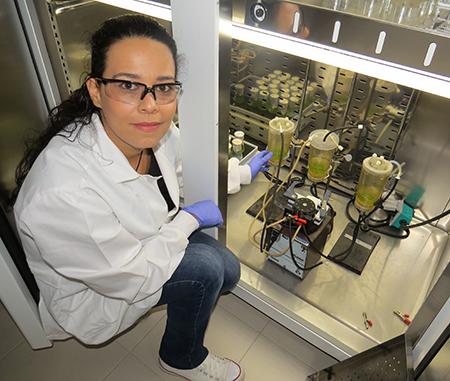Production of algae could take just days instead of weeks.
July 26, 2017

Washington State University researchers have developed a way to grow algae more efficiently — in days instead of weeks — and make the algae more viable for several industries, including biofuels.
Their work was reported in the journal Algal Research.
Researchers would like to produce algae efficiently because of its potential environmental benefits. Oil from the algae can be used as a petroleum alternative, and algae also can be used as food, feed, fiber, fertilizer, pigments and pharmaceuticals. Growing and harvesting algae in wastewater streams could also reduce the environmental footprint of many manufacturing processes.
However, its industrial use hasn't caught on, primarily because algae needs a lot of time and water to grow. Generally, large ponds are required, and harvesting is labor intensive. Researchers have begun developing biofilm reactors to grow the algae, but the reactors aren't efficient because of pH or temperature variations or a limited supply of carbon dioxide gas.
The researchers -- led by graduate student Sandra Rincon and her adviser Haluk Beyenal, professor in the Gene & Linda Voiland School of Chemical Engineering & Bioengineering -- developed a unique biofilm reactor that recycles gasses and uses less water and lower lighting than typical reactors.
The algae produced was full of the fats that make it suitable for biodiesel production and was "fatter" than algae produced from other biofilm reactors, Washington State said. Because of a removable membrane, it was also easier to harvest the algae than from typical systems.
The system is unique because it allows the algae to simultaneously do photosynthesis like a plant while also "eating" carbon and respiring like an animal, Beyenal said. The researchers fed the algae glycerol, a cheap waste product of biodiesel production, and urea, another inexpensive chemical that serves as a nitrogen source for the algae. Due to the design, carbon dioxide and oxygen are recycled in the system.
"The cell, in fact, becomes a very efficient factory in which the nutrients are supplied by the medium, but the cell metabolism meets its carbon dioxide requirements internally," Rincon explained.
The researchers have filed a patent application on the technology and are working to optimize the process. Funded through a Fulbright fellowship, the research aligns with Washington State's "Grand Challenges," a suite of research initiatives aimed at large societal issues. It is particularly relevant to the challenge of meeting energy needs while protecting the environment.
You May Also Like
.png?width=300&auto=webp&quality=80&disable=upscale)


